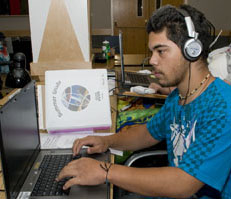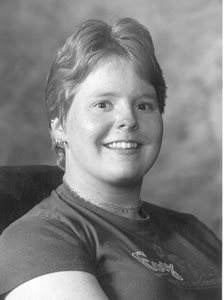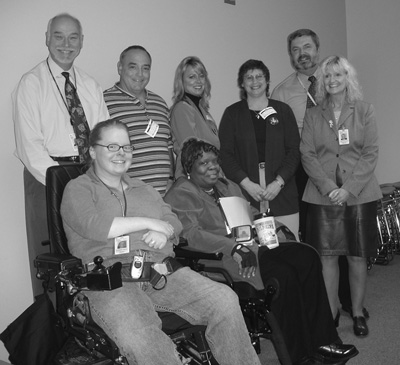Access to Computer Labs
Contents of This Section
The information covered in this section can be used to help ensure that computing resources are accessible to all students. The content provides guidelines for dealing with three key issues in the school setting:
- access to computer labs
- access to computers
- access to electronic resources
As more information is delivered using computer and network technologies, school computer labs play an increasingly important role in ensuring access to electronic resources.
Background
In making electronic resources accessible, principles of universal design should be employed. Typically, organizations design their services and facilities for the average user. Universal design means planning for people with a broad range of abilities and disabilities. Keep in mind that students may have learning disabilities and visual, speech, hearing, and mobility impairments.
To plan an accessible lab, think in terms of the following access issues: physical environment, adaptive technology, and electronic resources. These areas are addressed in the video and the handout Equal Access: Universal Design of Computer Labs. The checklist in the handout can be used as a starting point for surveying a school lab for accessibility. Following the guidelines ensures that lab visitors:
- feel welcome
- are able to communicate effectively with support staff
- can get to the facility and maneuver within it
- can access printed materials and electronic resources
- can make use of equipment and software
The guidelines also ensure that staff are trained to support students with disabilities and have a plan in place to respond to specific requests in a timely manner. With these key issues in mind, you can make your lab accessible to everyone.
The following general access issues are discussed in the guidelines:
- building access
- lab staff
- physical space and printed materials
- computers and software
- electronic resources

Tip: Making Computer Labs Accessible
In the Presentations section of this notebook, you will find guidelines and materials for delivering a presentation on making computer labs accessible.
First Steps
Lab managers can get started in creating an accessible lab by following these steps:
- Include students with disabilities in planning and evaluating lab products and services.
- Develop policies and procedures that ensure access to lab facilities, computers, and electronic resources for people with disabilities. Require that accessibility be considered in the procurement process.
- Ensure that the facility and services are wheelchair accessible and publications can be reached from a seated position.
- In key lab documents, include a statement about your commitment to universal access and procedures for requesting disability-related accommodations.
- Make signs with high contrast and large print.
- Make key documents available in formats accessible to those who have low vision and those who are blind (e.g., large print, Braille, electronic).
- Although a lab cannot be expected to have specialized equipment for every type of disability on hand, staff should make equipment available that they anticipate will be most often used or that is available at relatively low cost. This might include:
- an adjustable table for each type of workstation in your lab
- a wrist rest and forearm rest
- a trackball
- software to modify keyboard response such as sticky keys, repeat rate, and keystroke delay (that may be available in the operating system)
- software to enlarge screen images (that may be available in the operating system), large monitor; large-print keytop labels
- web resources that adhere to accessibility standards or guidelines adopted by the lab
- Once a lab is established and serves a large number of users, consider adding:
- text-to-speech software
- scanner and optical character recognition (OCR) software
- CCTV to enlarge printed documentation
- Braille translation software and printer
- word-prediction software
- hearing protectors
- keyboard guards to assist those who have limited fine motor skills
- alternative keyboards, mini-keyboards, or extended keyboards for users with mobility impairments
- speech input software
- one-handed keyboards or "keyboard layout" software
- Develop a procedure to ensure quick responses to requests for adaptive technology that you do not currently have available or for other disability-related accommodations.
- Train staff on available accessible products in the lab, on appropriate communication, and on procedures for addressing requests for accommodation. Include accessibility issues in all training offered in the lab.
- Include people with disabilities when addressing accessibility in periodic lab evaluations.

Achieving Career Goals: Marissa's Story
I always imagined myself in a cubicle in the office of a widely known company typing up reports, and that is exactly where I am today. Growing up using computers throughout elementary and middle school, it was natural for me to want to have a career that involved computers. There was no need for anyone to push me in that direction, though it helps that this is a field that, as my parents say, pays the "big bucks."
How I got here is an interesting story. I knew I wanted to go to college at about the same time I set my goal to graduate high school. I have cerebral palsy, and, until my senior year, I was the only person in a wheelchair at my high school. I had a circle of really good friends. We were the kind of people who got along with everyone, but we weren't all alike.
In my junior year, I began my journey with DO-IT. My geometry teacher, Cherie Smith, told me about this amazing opportunity, for which I owe her a lot. She told me the folks that make the DO-IT videos were looking for a student to feature in their next installment. I participated in the video then spoke on a DO-IT panel to inform math and science teachers about accommodations. After the panel, a DO-IT staff member approached me about joining the Summer Study Program, and I jumped at the chance. Summer Study was amazing. I got hands-on experience in college dorms and with the newest technologies. More importantly, I made lifelong friendships. DO-IT really opened me up and gave me a positive view of college life.
My disability was not really a factor in the classroom. I am just like any other person with classes I preferred and others I disliked but completed to the best of my ability. I always put schoolwork before any other after-school activities. In the computer lab I sat at an ADA station where the desk could be easily raised or lowered to accommodate my wheelchair. Although I type at an average 30+ wpm, I know I could still benefit from speech-to-text software if I took the time to look into acquiring it. I am eternally grateful for technologies like the computer. My hand would be forever aching if I didn't have access to one.
When it came time for my high school graduation in 1999, I began to consider attending college. At first, I was focused on earning my associate's degree at a community college and transferring to a four-year university. During my first year, I grew bored. I felt I wasn't getting anywhere taking the prerequisites for the Computer Information Server program. I wanted to get my hands on a computer! That summer I ended up missing the deadline for financial aid, and my summer break ended up being closer to two years.
As the two-year marker neared, my mom was urging me to return to school, and I wanted to as well. So I sought out a counselor at the Division of Vocational Rehabilitation who helped me to rethink the path I wanted to take. I realized I enjoyed working with computer applications rather than trying to fix internal computer problems. I'm so glad I took the time to figure that out or I'd be getting up everyday absolutely hating my career.
In January of 2002, I re-entered the community college world excited about the new direction I was taking. I started back to school with eight credits, but as I began to enjoy the things I was learning as each quarter progressed, I wanted to challenge myself with more until I was exceeding a full-time schedule.
After I returned to school, happy with my chosen career path, I experienced some great success. In the fall of 2003, one of my instructors approached me with the idea of applying to become a tutor for the business technology classes. I soon found myself among my peers helping them with their schoolwork. Twice I made the Vice President's list for academic achievement. I also found an internship in the offices of a performing arts center. A friend of mine told me about the internship, which gave me good practical experience and taught me the value of networking through friends and family.

To fulfill my second internship requirement I worked with DO-IT staff and set up an internship with Amazon.com, that big-name company I had always pictured myself working for! At first I was excited to be working at the company I'd always dreamed of. But soon I realized that, although it was an excellent learning experience, it did not live up to my expectations. The job was fine, but it wasn't for me. Shortly after completing the internship at Amazon.com, in March of 2005, I graduated from community college with not just one but two degrees: business management and administrative assistance in professional technical programs.
Employment was my obvious next step. I worked hard to finish school. My degree means a lot to me and will get me somewhere in life. After graduation, I contacted DO-IT again to work on my resume and get another internship going, this time with the Federal Aviation Administration (FAA). Previously I'd never thought I'd want to work in government, but the job I was doing at FAA surprised me, and I loved it. When the internship ended they offered me a full time position, and now I work there in a permanent position with benefits! This really is what I wanted.
As I said in my introduction, I've always pictured myself sitting in a cubicle of a widely known company, happy as a clam, utilizing my newly acquired skills as an administrative assistant, possibly climbing the ladder to office manager, and that is where I am today. Staying in touch with DO-IT even after completing the Scholars program has allowed me to come to the staff for assistance in obtaining additional internships, getting help updating resumes, practicing interview skills, and ultimately securing a great job.
I have been and always will be a big yet simple dreamer. "I'm not here to conquer the world, just to be happy and comfortably living in it."